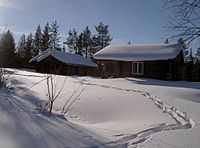"Standard" Finnish sauna

(A modern, pre-fabricated Finnish wooden cabin, called mökki, surrounded by deep snow)
In Finnish country houses they use timber to heat the saunas, while city dwellers use electricity for heating. In urban setting people practically cover the walls of one small room with wood for the purposes of using it as a sauna.
The summer cottage of a Finnish holiday home, the mökki is generally located on a lakeside and it has a sauna attached to it. People, having taken their saunas, jump into the lake water in order to cool their bodies. In winter it is necessary to cut a whole in the ice on the surface of the lake to be able to jump into the water. Some people rub themselves with snow or just stand outsdorors at -20-30 °C to cool themselves. They do not feel cold for several minutes after the heat of the sauna, the cold water or the cold air feel good for them.
The number of saunas in Finland is about 2 millions; 1.2 millions of these can be found in private homes, the remaining 800 thousand in holiday homes (mökkis), hotels and swimming pools. It is a relatively large number considering, that the number of inhabitants in Finland is about 5 million. In addition, the number of saunas has been on the increase: in 1938 it was only 1.5 million. .
As the English consider 5-o’clock tea a national tradition, the sauna plays the same role int he life of the Finnish people. They take a sauna at least once a week, mostly at weekends. It is also a custom to invite friends and other families for a sauna. It practically means a several-day pastime. The sauna room or cabin is usually heated up by 5 or 6 o’clock on a Saturday afternoon and after taking the sauna people enjoy several hours of relaxation. The after-sauna meal consists of sausages and beer. It is called lenkkimakkara – it is a very appetizing word for the Finnish people. .
Wherever the Finnish people go they take a miniaturized version of saunas with themselves, even when they go on holidays. It is not rare that we can see saunas at campsites or on boats.
Saunas have become part of everyday life: present-day people in Finland do not know why other people are surprised when they see Finnish saunas. Finnish children have always been taught how to behave in a sauna, similar to the way other children are taught for eaxample how to behave in church. Saunas have been part of people’s life from early childhood through adulthodd to old-age. It has always been considered a ’holy’ place. Finnish women used to give birth to their babies in saunas and these used to be the places, too, where the Finnish people said good-bye to their deceased family members.
The sauna tradition is continued.
The traditions of using smoke saunas and taking saunas on a regular basis have been kept until today. This fact is attested by original reports and the research done by Finnish ethnographers. They all described that the Finnish people poured water on hot stones, beat their bodies with twigs and after that they swam in a lake or rolled over in snow.
Until these days the Finnish sauna have been identical with the place where people wash themselves, and, at the same time it is a place for physical and mental rejuvenation. In recent times people have rediscovered the incomparable benefits of smoke saunas and the popularity of these is growing.
Source: wikipedia.org